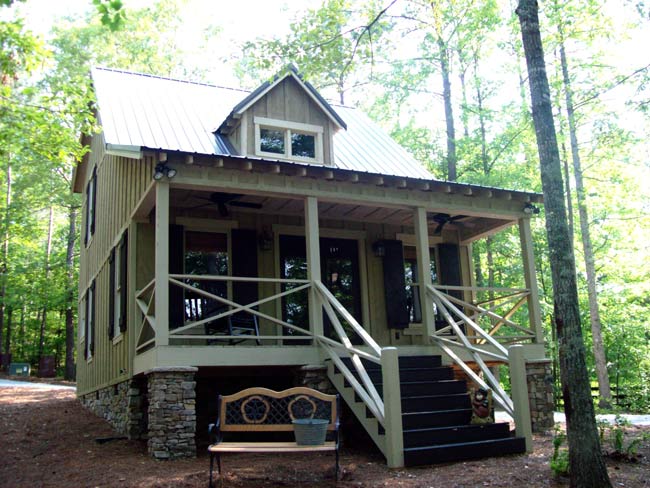

Residential House Plans
Main Floor:
538 sq. ftUpper Floor:
256 sq. ftLower Floor:
noneHeated Area:
794 sq. ft.Width:
23'Depth:
32'6"Bedrooms:
1Bathrooms:
1Stories:
2Additional Rooms:
Upstairs LoftGarage:
noneOutdoor Spaces:
Front Porch, Rear PorchOther:
Open Living, Vaulted CeilingsRoof:
Exterior Framing:
2x4 or 2x6Ceiling Height:
9'Home Style:
Guest House, Cabin, Small LotLot Style:
Small Lot, Corner LotHatchet Creek Cabin is a small guest house plan that was designed as a guest house for a customer that wanted to have her parents near her lake house while also having her privacy in her own home. You enter the home to an open living room, cozy fireplace and kitchen with a loft above. Vaulted ceilings create the feeling of living large in a smaller home. The loft upstairs is enclosed by a balcony that provides views below and it has its own bath and walk-in closet. This plan works great as a second home on the same lot for guests or your parents.

Each set of plans includes:







Notes:
All sales on house plans and customization/modifications are final. No refunds or exchanges can be given once your order has started the fulfillment process. All house plans from maxhouseplans are designed to conform to the local codes when and where the original house was constructed. In addition to the house plans you order, you may also need a site plan that shows where the house is going to be located on the property. You might also need beams sized to accommodate roof loads specific to your region. Your home builder can usually help you with this. Many areas now have area-specific energy codes that also have to be followed. This normally involves filling out a simple form providing documentation that your house plans are in compliance. In some regions, there is a second step you will need to take to insure your house plans are in compliance with local codes. Some areas of North America have very strict engineering requirements. New York, New Jersey, Nevada, and parts of Illinois require review by a local professional as well as some other areas. If you are building in these areas, it is most likely you will need to hire a state licensed structural engineer to analyze the design and provide additional drawings and calculations required by your building department. If you aren’t sure, building departments typically have a handout they will give you listing all of the items they require to submit for and obtain a building permit. Additionally, stock plans do not have a professional stamp attached. If your building department requires one, they will only accept a stamp from a professional licensed in the state where you plan to build. In this case, you will need to take your house plans to a local engineer or architect for review and stamping.